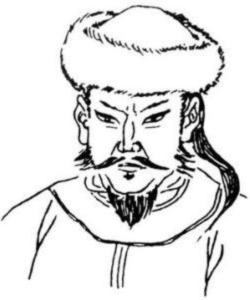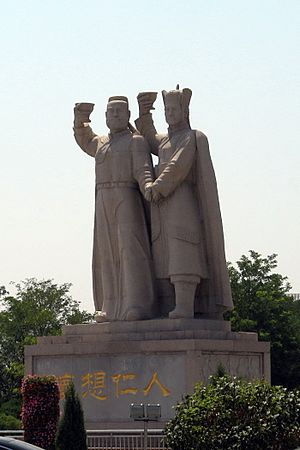Abaoji facts for kids
Quick facts for kids Emperor Taizu of Liao遼太祖 |
|||||||||||||||||||||
|---|---|---|---|---|---|---|---|---|---|---|---|---|---|---|---|---|---|---|---|---|---|
| Emperor of Khitan Empire | |||||||||||||||||||||
 |
|||||||||||||||||||||
| 1st Emperor of Liao Dynasty | |||||||||||||||||||||
| Reign | 916–926 | ||||||||||||||||||||
| Predecessor | Dynasty established | ||||||||||||||||||||
| Successor | Emperor Taizong | ||||||||||||||||||||
| Born | Abaoji (阿保機) 872 |
||||||||||||||||||||
| Died | 6 September 926 (aged 53–54) | ||||||||||||||||||||
| Burial | Zuling Mausoleum (祖陵, in present-day Bairin Left Banner, Inner Mongolia) | ||||||||||||||||||||
| Spouse | Empress Shulü Ping | ||||||||||||||||||||
|
|||||||||||||||||||||
| House | Yelü | ||||||||||||||||||||
| Dynasty | Liao | ||||||||||||||||||||
| Father | Yelü Saladi | ||||||||||||||||||||
| Mother | Xiao Yanmujin | ||||||||||||||||||||
| Abaoji | |||||||||
|---|---|---|---|---|---|---|---|---|---|
| Traditional Chinese | 阿保機 | ||||||||
| Simplified Chinese | 阿保机 | ||||||||
|
|||||||||
| Emperor Taizu of Liao | |||||||||
| Traditional Chinese | 遼太祖 | ||||||||
| Simplified Chinese | 辽太祖 | ||||||||
|
|||||||||
| Yelü Yi (sinicised name) | |||||||||
| Chinese | 耶律億 | ||||||||
|
|||||||||
Abaoji (born 872, died September 6, 926) was a powerful Khitan leader. He is known as the Emperor Taizu of Liao. He founded the Liao dynasty in China and ruled as its first emperor from 916 to 926.
Abaoji also had a Chinese name, Yelü Yi. Some historians believe his family name, Yelü, was adopted during his lifetime. He was born in 872 in what is now Inner Mongolia. His childhood was difficult; his grandfather was killed, and his father and uncles had to flee. His grandmother kept him hidden to keep him safe.
Abaoji became the leader (khagan) of the Khitans on February 27, 907. He was later crowned emperor in 916. He died on September 6, 926. He was important for conquering and uniting all of Inner Mongolia, northern China, and southern Manchuria. After the Khitan Empire became the Liao dynasty in 942, Abaoji was officially recognized as a Liao emperor.
Contents
Amazing Birth Stories
Later Chinese historians wrote many legends about Abaoji's birth. One story says his mother, Xiao Yanmujin, dreamt the sun fell into her arms. After this, she became pregnant. When Abaoji was born, the room was said to fill with a mysterious light and a wonderful smell.
The legends also claim that Abaoji was born looking like a three-year-old. They even say he could walk when he was only three months old! Some stories suggest he could see future events before they happened.
Rise to Power
The Khitans lived on the east side of the Greater Khingan Mountains. Other nomadic tribes lived nearby, like the Shiwei and Xi. The Turkic Uighur tribe also lived there. These tribes often married into the Khitan families. Further west were the Tatars, a strong warrior tribe. To the east and northeast were the Jurchens, who were peaceful hunters and fishers. Across the Liao River to the east lived the Balhae people, who were mostly farmers.
For many years, the Yaonian clan had led the Khitan tribes. They had good relationships with the Tang dynasty to the south. However, by the late 800s, leaders of the powerful Yila tribe were unhappy with the Yaonian khans. Abaoji's father had been the elected chief of the Yila tribe.
Abaoji became the chief of the Yila tribe in 901. In 903, he was named the Yuyue, which meant he commanded all Khitan military forces. This made him second in power only to the great khan. He gained fame in 905 when he led 70,000 cavalry into Shanxi. There, he formed a close bond with Li Keyong and promised to support him against Zhu Wen. This showed he was more daring than the current Great Khan.
In 907, Abaoji attended the triennial council. He demanded to be named the khagan, or "Khan of khans." His victories against the Han people in the north, which he had been raiding since 901, helped him gain support. Seven tribal chiefs backed him, and even the last Yaonian Great Khan agreed.
From 907 to 916, Abaoji faced many uprisings and rebellions. Most of these were started by his own family members, like his cousins and brothers. He eventually convinced them that they would be more successful if they worked together as a dynasty. He built a walled city to show off the tribe's wealth and power. He also gave important positions to those who had rebelled, which made them happy. Abaoji was very skilled at handling his enemies, which helped him increase his own power and his tribe's influence.
Abaoji's Lasting Impact
Abaoji's success came from his ability to bring new ideas to Khitan society. One of his most important changes was creating a dual system of government. Nomadic people would follow their traditional steppe laws. But settled populations in conquered areas, like Balhae and north China, would be governed by a civil system. This system was largely based on Han rules.
This new system did not please all tribal leaders, as it reduced their power. However, it became a model for later nomadic groups to rule their large empires.
Two other key changes happened in 916. Abaoji adopted Chinese court customs. He declared himself "Celestial Emperor" and used a Chinese-style era name. This was a big step. Second, he named his son, Yelü Bei, as his chosen heir. This was new for Khitan society, which usually chose leaders based on merit, not birth. This change was not always easy, and only a few of his successors had smooth transitions to power.
Abaoji also organized his followers into warrior groups called orda. He then combined 12 ordas to form an administrative district.
In 918, Abaoji ordered a new walled city to be built. Next to it, a Chinese city was constructed with shops for artisans, merchants, and warehouses. Later, five capital cities were built, including a Supreme Capital (上京). This city became the main center for Khitan administration.
Abaoji ordered the creation of a Khitan large script in 920. This writing system looked a bit like Chinese writing but was very different. Five years later, a Uyghur group visited. This led Abaoji to ask his younger brother, Yelü Diela, to create a new script. This new script was based more on syllables. Unlike the Japanese and Koreans, the Khitans adopted writing without fully taking on Chinese culture and grammar.
By the time he died at 54 from typhoid fever, Abaoji had conquered the entire Balhae state. He allowed their ruling family to remain as nobles in his new territory. His empire reached the Yalu River and the Ussuri River in the east. To the west, his control extended far onto the Mongolian Plateau. He had planned to move south into China but died before he could.
Relationship with the Later Tang

Li Cunxu, the son of Li Keyong, founded the Later Tang dynasty in 923. He had formed a bond with Abaoji back in 905. When Li Cunxu died, relations between the two groups had become difficult. Still, an envoy was sent to the Khitan capital to follow proper customs. The relationship likely worsened because Abaoji became very aggressive. In 922 and 923, he led his army deep into Hebei, which was Later Tang territory. He looted and took prisoners along the way.
Yao Kun's Mission
Yao Kun was sent by the Later Tang court to meet Abaoji in 926. He found the Khitan ruler in Manchuria. Abaoji was on a military campaign against the Balhae kingdom. He was camped at Fuyu, in present-day Jilin Province. Abaoji demanded that the Later Tang give up the Sixteen Prefectures. He said if they did, he would not invade China proper. Yao Kun replied that he did not have the power to agree to this demand. Because of this answer, Yao Kun was put in prison. He was still there when Abaoji died from illness on September 6, 926.
Who Ruled Next?
Even though Yelü Bei was named Abaoji's heir in 916, his mother, Empress Dowager Shulü Ping, did not think he was worthy. She managed to have her second son, Deguang, become the next ruler. Deguang became known as Emperor Taizong of Liao. He ruled from 926 to 947.
Family
Consort and children:
- Empress Chunqin, of the Xiao clan (born October 19, 879 – died August 1, 953), personal name Shulü Ping
- Yelü Zhigu (died 911), 1st daughter
- Married Xiao Shilu, who was Empress Shulü Ping's half-brother.
- Yelü Bei, Emperor Yizong (889 – January 7, 937), 1st son
- Yelü Deguang, Emperor Taizong (born November 25, 902 – died May 18, 947), 2nd son
- Yelü Lihu, Emperor Zhangsu (911–960), 3rd son
- Yelü Zhigu (died 911), 1st daughter
- Palace lady, of the Xiao clan
- Yelü Yaliguo, 4th son
See Also
 In Spanish: A Bao Ji para niños
In Spanish: A Bao Ji para niños
- Liao dynasty
- Song dynasty
- Khitan
- Yelu clan
- Ambaghai khan of the Khamag Mongol


